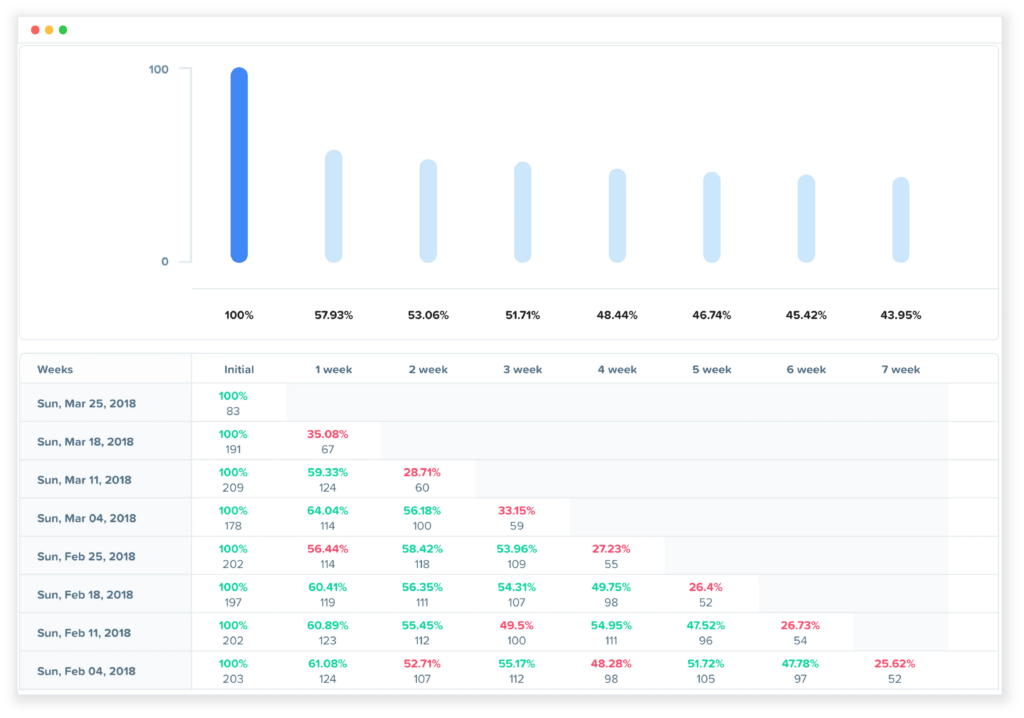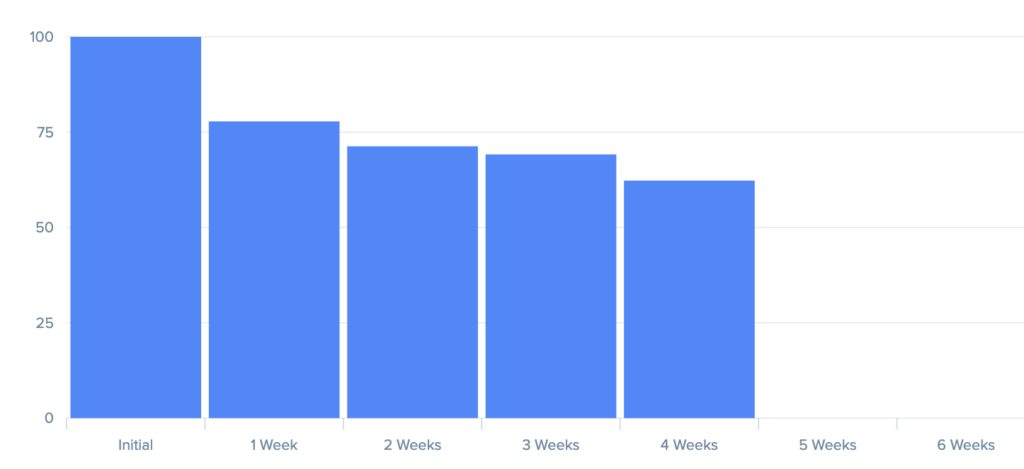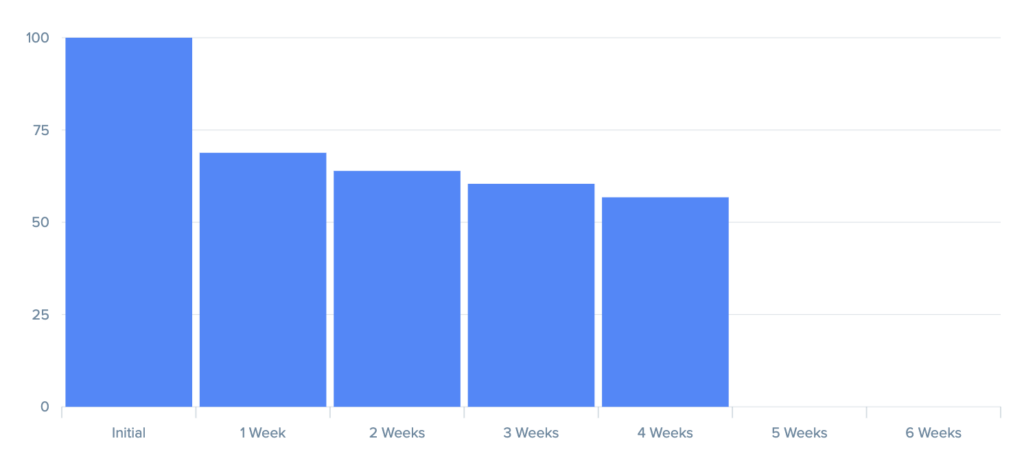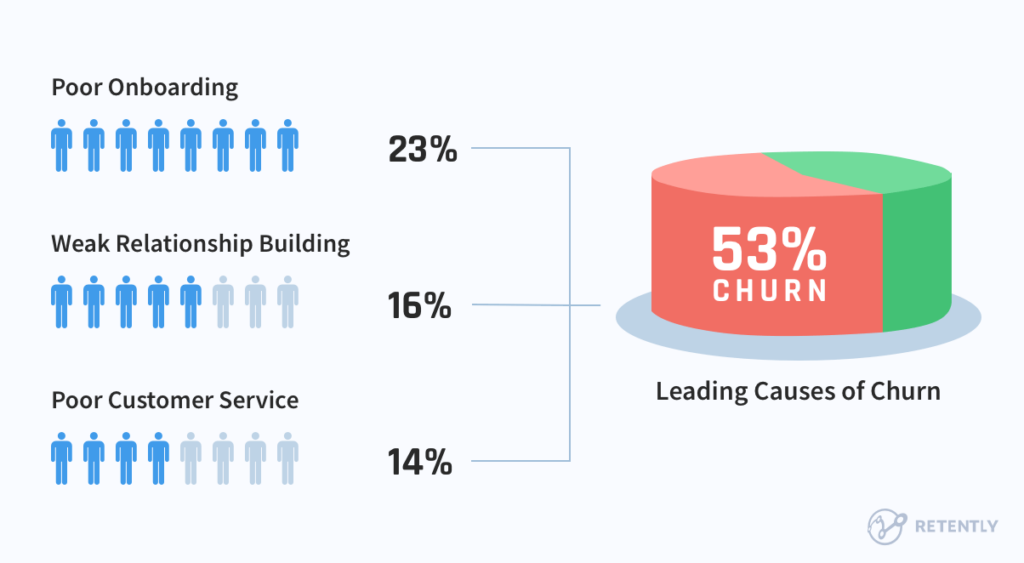Churn, by nature, is baked into the SaaS industry. Whenever you run a subscription-based company, a certain percentage of users will inevitably churn. There’s no getting around it. That said, you want to stay on top of turnover and do everything you can to maximize SaaS customer retention.
To quantify, revenue intelligence company Gong says you should aim to keep your churn rate under 3%.
In this post, we’ll go over ultra-practical steps you can take to accomplish this, while also providing your customers with a consistently positive experience.
Start with Retention Analytics Reports to See the Big Picture
Like any sound business decision, it’s important to start with objective data so you can see what’s happening and what’s causing the bulk of users to leave. To obtain this data, I suggest using a customer journey analytics tool like Woopra.
It offers detailed retention analytics reports that let you:
- Measure your churn rate
- See how long customers use your product before churning
- Determine why you’re losing customers
- Identify specific areas of improvement that can lower your churn rate in the future
For instance, you can get a bird’s-eye view of your churn rate over time.

You can see how many customers return after using a core product feature.

.
You can see what your product retention rate is for mobile users…

..and much more.
Armed with this data, you’ll be able to diagnose any leaks that are contributing to higher-than-ideal churn so you’ll know which areas need your attention. That way, every decision you make is based on tangible evidence rather than merely going on a hunch.
Identify At-Risk Customers
Another helpful feature of retention analytics is that it can help you identify at-risk customers — those that have a higher-than-average chance of churning.
Say, for example, a particular customer hasn’t logged into their account for an extended period of time or is engaging with your product far less than most other users. They would likely have a higher chance of churning than another user who logs in every day and frequently uses a variety of product features.
By proactively catching at-risk customers before they leave, it gives you an opportunity to create a better experience and appeal to them before it’s too late, thus increasing their chances of hanging around longer.
Here are a few potential ways to do that:
- Have a team member reach out to the at-risk customer directly to see what they can do to improve their experience
- Provide resources to help the customer get the most out of your product
- Offer an incentive such as a discount to encourage them to keep using your product
Note that any feedback gained through team member interactions should be logged so it can be used to prevent similar issues from happening in the future. For example, if a customer mentions that a specific product feature is frequently glitchy, you would want to fix it ASAP.
Optimize SaaS Onboarding
Research by customer success platform Retently found that the number one leading cause of churn is poor onboarding, accounting for 23% of overall churn.

And this makes complete sense. Just put yourself in the shoes of a new customer who is initially excited about using your SaaS product. However, after experiencing an excessive amount of friction during onboarding, they could quickly sour and jump ship to another competitor.
If this happens at scale, you can have a serious churn crisis on your hands. That’s why efficient onboarding should be a top priority for every SaaS company.
By making onboarding smooth and seamless, this not only minimizes early churn, it sets the tone for long-term rapport-building so you can maximize customer lifetime value and get more loyal brand advocates.
Here are some specific ways to optimize SaaS onboarding:
- Send welcome emails with tips on how to efficiently learn how to use your product
- Offer an extensive onboarding resource section with tutorials and walkthroughs
- Create a detailed troubleshooting and support section for users who run into issues
- Provide every user with a point of contact if they need one-on-one assistance
Also, be sure to continually ask for feedback so you can identify problem areas that need work.
Rev Up SaaS Customer Support
Unsurprisingly, poor customer support is another chief reason for SaaS turnover, with 14% of users leaving because of lackluster customer support.
I think this is an issue that nearly everyone can relate to. Personally, I’ve found this to be something that’s turned me off from continuing to use tools, and I’ve switched to other products because of bad customer support. After all, nothing is more frustrating than having an issue and struggling to find a quick resolution, especially after you’ve spent good money on a product.
The bottom line is that you should strive to offer A+ customer support, where users can seamlessly get assistance without jumping through a bunch of hoops.
Here are some suggestions for achieving that:
- Offer 24/7 support through a variety of channels, including phone, live chat, email, and social media
- Create a self-help center where users can find solutions to common issues
- Provide walkthroughs on product updates so users can easily learn new features
- Follow up with customers after they seek support to ensure their issues have been fully resolved
For more details on creating amazing customer support, I suggest reading this guide from Help Scout.
Making Customer Retention a Top Priority
SaaS is an incredibly competitive industry, and excessive customer turnover can make it incredibly difficult to gain any momentum. After all, if you’re on a hamster wheel of continually replacing lost customers, your progress will be minimal.
However, by following best practices like implementing retention analytics, identifying at-risk customers before they leave, optimizing onboarding, and fine-tuning customer support, you should keep churn in check and boost overall customer lifetime value. Not to mention, it makes for a more enjoyable customer experience, which sets your business up for long-term success.
Ready to build an elite team of SaaS salespeople? Register with HireDNA to attract, recruit, and retain the best of the best.



